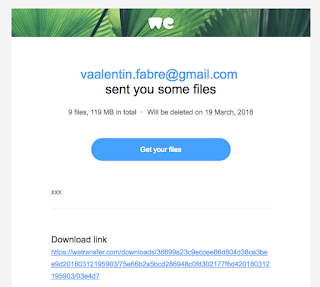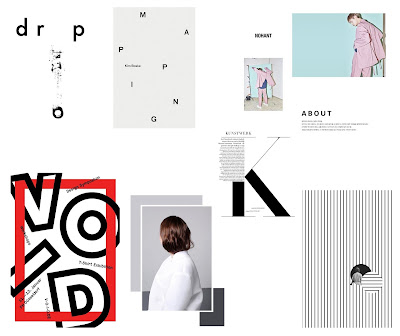Wednesday, 28 February 2018
Monday, 26 February 2018
Friday, 23 February 2018
A Road Magazine - Meet up and Contract
A meeting between Sam and I took place to discuss the project and the contract of our collaboration.
It was decided we would have weekly meetings or at least communicate over email/social media on a weekly basis to keep up with the work process and give each other feedback on the design of the publication.
The deadline for the project is May, however, we agreed finishing the design process earlier was necessary in order to get the publication printed in time.
The design of the magazine was discussed within the meeting. Prior to the meeting visual research was undertaken as the brief states "champion modern, exciting and creative design with a heavy focus on photography to create an alternative view of a saturated market".
Colour scheme: Minimal, with perhaps a splash of colour against monochrome. It was mentioned perhaps a red would be used for parts of type and possibly imagery in relation to road signs.
Typefaces: A contextual typeface has been chosen by the client in relation to the theme of the publication.
It was decided we would have weekly meetings or at least communicate over email/social media on a weekly basis to keep up with the work process and give each other feedback on the design of the publication.
The deadline for the project is May, however, we agreed finishing the design process earlier was necessary in order to get the publication printed in time.
The design of the magazine was discussed within the meeting. Prior to the meeting visual research was undertaken as the brief states "champion modern, exciting and creative design with a heavy focus on photography to create an alternative view of a saturated market".
Colour scheme: Minimal, with perhaps a splash of colour against monochrome. It was mentioned perhaps a red would be used for parts of type and possibly imagery in relation to road signs.
Typefaces: A contextual typeface has been chosen by the client in relation to the theme of the publication.
These typefaces (http://www.cbrd.co.uk/fonts) are official British road signs and it has been suggested by the client to include them within parts of the design. Experimental layouts will use these types to see if they are successful.
The client also stated to not be restricted by these typefaces and to include various ones that would compliment a modern design. It was said in the meeting that bold fonts were of interest.
Here were a few initial layout designs that were curated based on the modern and non-commercial themes the client has asked for. It was agreed I experiment with the content he initially has and from there design layouts until we agree on a structure and aesthetic that best suits the magazine's intentions.
Thursday, 22 February 2018
A Road Magazine - Live Brief and Collaboration
Samuel Dennis, Photography Level 6
A Road Magazine is a new platform to share automative stories through photo essays and journalism. The publication will shun the commercialism and glossy pages of traditional motoring magazines and instead champion modern, exciting and creative design with a heavy focus on photography to create an alternative view of a saturated market.
A graphic designer is needed to work alongside the editor to create a layout template. This is including, but not limited to, front/back cover, contents page, and general page layout for features. The design will be primarily minimal, simple and modern that will emphasise the imagery.
This brief is open to anyone who is interested in publication design and does not necessarily have to interested in motoring. This will be a great opportunity to build your portfolio and a chance to possibly earn a little cash (if funding allows).
A Road Magazine is a new platform to share automative stories through photo essays and journalism. The publication will shun the commercialism and glossy pages of traditional motoring magazines and instead champion modern, exciting and creative design with a heavy focus on photography to create an alternative view of a saturated market.
A graphic designer is needed to work alongside the editor to create a layout template. This is including, but not limited to, front/back cover, contents page, and general page layout for features. The design will be primarily minimal, simple and modern that will emphasise the imagery.
This brief is open to anyone who is interested in publication design and does not necessarily have to interested in motoring. This will be a great opportunity to build your portfolio and a chance to possibly earn a little cash (if funding allows).
Spectrum - Target Audience
Ages: 15-25
This demographic has been altered from the last issue (18-25) as reaching a younger audience is important with the subject matter. Gender is process of self-discovery for some people, so lowering the target audience age opens up to a younger audience that could be beneficial for people struggling with their gender identity. Including written content and photographic visuals for a younger audience would achieve this.
Seeing as the magazine content for this issue will be based around femininity and masculinity of men, it would appear the target audience would be shifted towards the male demographic. However, seeing as the magazine is targeted towards non-binary and people who believe gender is in fact a 'Spectrum' the problem of isolating the female audience is non-existent in this instance. Mainstream magazines take of themes for a number of there issues in order to discuss a variety of topics, so by focusing the issue on men's gender identity it should not alienate an audience outside of the subject matter, as it all links to the issues of gender identity that society faces.
Fashion magazine demographic research
'Out magazine, puts it, "Our demographics are more appealing that those of 80-year-old Christian ladies."
'Advertising trends indicate that corporations are cleaning to gay publications that promote a stylish, widely palatable vision of gay life, primarily mags such as Out.'
'Corporate interest in the gay market has not arisen of its own accord. Rather, it has been piqued by organisations - usually run by gays - that conduct surveys and employ selected information about gay consumers to persuade advertisers that a viable gay and lesbian market exists.'
(https://books.google.co.uk/books?id=9MoVCgAAQBAJ&pg=PA519&lpg=PA519&dq=queer+demographic+magazine&source=bl&ots=VYupeGSkfz&sig=2UMVGMgFuLwnHY0z2O3Vp5m26sc&hl=en&sa=X&ved=0ahUKEwi-weTz7rnZAhWlDMAKHfU1DnwQ6AEIXjAF#v=onepage&q=queer%20demographic%20magazine&f=false)
This demographic has been altered from the last issue (18-25) as reaching a younger audience is important with the subject matter. Gender is process of self-discovery for some people, so lowering the target audience age opens up to a younger audience that could be beneficial for people struggling with their gender identity. Including written content and photographic visuals for a younger audience would achieve this.
Seeing as the magazine content for this issue will be based around femininity and masculinity of men, it would appear the target audience would be shifted towards the male demographic. However, seeing as the magazine is targeted towards non-binary and people who believe gender is in fact a 'Spectrum' the problem of isolating the female audience is non-existent in this instance. Mainstream magazines take of themes for a number of there issues in order to discuss a variety of topics, so by focusing the issue on men's gender identity it should not alienate an audience outside of the subject matter, as it all links to the issues of gender identity that society faces.
Fashion magazine demographic research
'Out magazine, puts it, "Our demographics are more appealing that those of 80-year-old Christian ladies."
'Advertising trends indicate that corporations are cleaning to gay publications that promote a stylish, widely palatable vision of gay life, primarily mags such as Out.'
'Corporate interest in the gay market has not arisen of its own accord. Rather, it has been piqued by organisations - usually run by gays - that conduct surveys and employ selected information about gay consumers to persuade advertisers that a viable gay and lesbian market exists.'
(https://books.google.co.uk/books?id=9MoVCgAAQBAJ&pg=PA519&lpg=PA519&dq=queer+demographic+magazine&source=bl&ots=VYupeGSkfz&sig=2UMVGMgFuLwnHY0z2O3Vp5m26sc&hl=en&sa=X&ved=0ahUKEwi-weTz7rnZAhWlDMAKHfU1DnwQ6AEIXjAF#v=onepage&q=queer%20demographic%20magazine&f=false)
Wednesday, 21 February 2018
Spectrum - Issue 02 Brief
Spectrum is a fashion editorial magazine that was created as part of the outcome for COP3. The editorial focused on a gender identity as a whole, exploring the side of mainstream editorial design that often excludes and under-represents identities that do not conform to binary gender ideals. The design of the magazine was a collabortation of experimental design, often found in zine culture, and modern editorial design. A blend of the two meant gender identity as a subject matter could be represented using mainstream design techniques in order to achieve more exposure to the problem of underrepresentation. The magazine featured over 8 photographers from around the globe, creating a network/relationship and contact has been kept, as a result, creating opportunity to collaborate again in the future.
Brief:
Spectrum is a visual platform for various forms of gender identity to be explored through photography, type and journalism. The publication will continue to express concepts of gender that mainstream magazines often fail to include in their content. This particular issue will be focusing on femininity within masculinity in effort to breakdown gender stereotypes that men face in western society.
The design of this issue is subject to change as a push for a more mainstream layout would gain more attention for the magazine; a main goal for the magazine. Production will focus on commercialism of glossy high fashion magazines.
The editor will be in control of the graphic design, photography, journalistic elements, production and packaging. Photography will be a collaboration between working professionals and university students, each will be credited when featured.
Subscribe to:
Comments (Atom)
















































